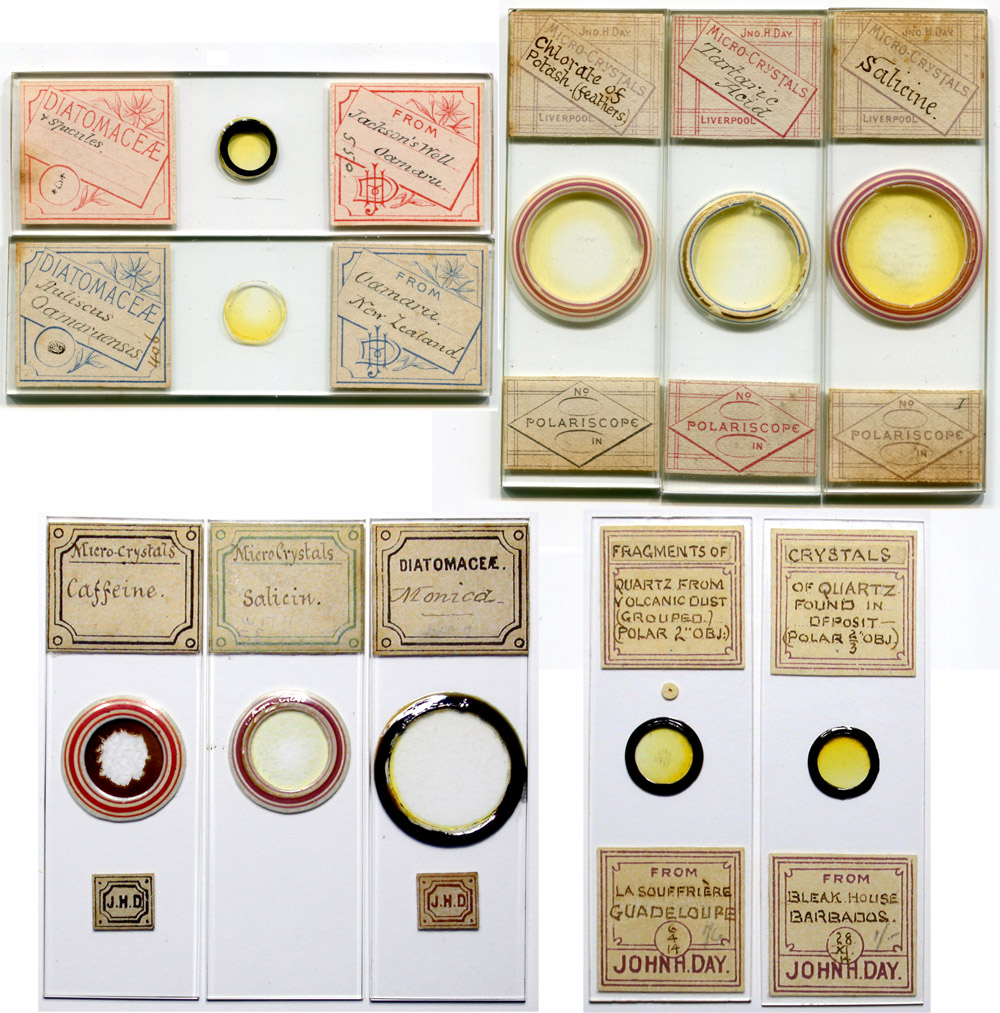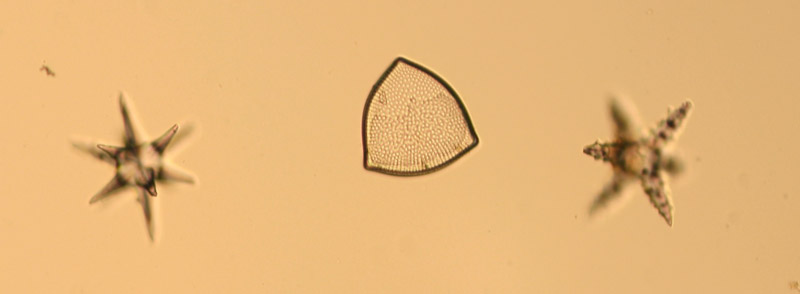John Henry Day, 1840 - 1916
by Brian Stevenson
last updated December, 2014
Despite
the professional appearance of the majority of John H. Day’s microscope slides
(Figure 1), he was strictly an amateur in the field. His surviving slides
probably come from Day’s personal collection, society members with whom he
shared preparations, and from dispersed society property. He was a long-time
associate of the Microscopical Society of Liverpool and the Chester Society of
Natural Science, recorded as having exhibited and donated microscope slides to
those societies as early as 1871. Day resigned his membership in the Liverpool
Microscopical Society at some point between 1895 and 1906, suggesting that he
had lost enthusiasm for the hobby. Thus, J.H. Day slides probably date between
ca. 1870 and the 1890s.

Figure 1.
Examples of microscope slides prepared by John H.
Day. Slides with labels such as those shown at the lower right generally
contain three numbers in the circle of the lower label, the third of which is
known to range between 13 and 15. If those numbers indicate dates of production,
then these slides would be from the last few years of Day’s life, a time at
which he did not have any known involvement with microscopy. Alternatively, the
numbers may be collection reference numbers – for example, the 13th – 15th
sessions of the Microscopical Society of Liverpool occurred between 1879 and
1884, when Day was active with that club.

Figure 2.
Arranged diatom and spicules, the specimens on the Jackson’s Well, Oamaru slide shown in Figure 1.
John Henry
Day was born during late 1840 in Walsall, Staffordshire, England. He was the
second child, and first son, of surgeon John Day and his wife, Fanny. The Days were
evidently education-minded, and sufficiently well-off that they could send John
to boarding school; the 1851 census found the 10 year-old as a pupil at Henry
Hopkins’ school in Birmingham. In 1861, he was boarding in Tranmere,
Birkenhead, across the Mersey River from Liverpool, and was an “apprentice to a merchant”. Day lived in
that general area for the next forty or so years.
The 1871
census recorded John Day as being a “banker’s
clerk”, boarding in the Everton district of Liverpool. That year also marks
the earliest known record of his interest in microscopy. On March 3, “Mr. J. H. Day made
a donation of twelve slides of seeds” to the Microscopical Society of
Liverpool. Curiously, although he made numerous other donations and
presentations to the Liverpool society, he did not become a member until 1887.
There must have been a close association, however, since Day was elected to the
society’s Executive Council in the same year that he joined.
Unlike so
many amateur microscopists of his time, John Day does not appear to have placed
exchange requests in national magazines. Presumably, he acquired a sufficient
diversity of specimens through his club contacts. Thus, the records we have of
Day’s interests come from society reports. Crystals predominate, but diatoms,
botanical and insect specimens were also mounted.
Examples
of Day’s exhibits and donations include: “microscopic
crystals”, “fluid cavities in quartz”,
“copper and other ores which presented a
very pretty effect when viewed through the microscope”, and “rock sections (polarised)” at the Annual
Conversaziones of the Chester Society of Natural Science of 1876, 1877, 1878,
and 1879, respectively. A donation of “six
slides, crystals” was made to the Microscopical Society of Liverpool in
April, 1878, and a “section of Wigan coal”
was exhibitd to the same group that October. Also shown to the Liverpool
society were “diatoms, Coscinodiscus
Radiatus, &c., mounted dry” (April, 1879), and “two slides of crystals of platino-cyanide of magnesium” (June
1879). Day exhibited “sections of wood,
coal and fossil wood” at the 1880 conversazione of the Liverpool Chemists' Association in January, 1880. Day
remained on the rolls of the Liverpool Microscopical Society through at least
1895, but is not otherwise mentioned in the society’s Annual Reports of the
1890s.
The latest
known record of Day as an active microscopist is a brief note published in The Journal of Microscopy and Natural
Science, 1893, “Volvox globator, To
Mount - The gathering should be first strained through fine muslin and the
residue placed on a glass slip while quite wet. Surround this with a ring of
glycerine jelly, very slightly warmed. and finish off when cold with cement in
the usual way. The secret of the bright green colour being preserved is to
collect and mount at once, or as soon after collecting as possible”.
An interest
in photography is evident by the early 1880s, and continued through the rest of
the century. That hobby may have supplanted microscopy for Day’s use of free
time. In 1883, he was elected to be a Vice President of the Liverpool Amateur
Photographic Association and, in 1895, the club’s President. In February, 1884,
“Mr. J.H. Day passed round a beautiful transparency which
had been developed in a room lit by a naked gas flame, and yet without a trace
of fog”, and, that September, “Mr. J.H. Day said he
had obtained good results with Morgan’s paper, and showed a print from a waxed
negative, which was perfectly sharp, and could not be distinguished from an
ordinary glass negative”. Later in 1884, Day was instrumental in forming
the Birkenhead Photographic Association, and served as that club’s first
Secretary.
The last
identified non-governmental record of John H. Day’s life relates to his
interest in photography. It also indicates that he was somewhat of an
adventurous traveler. An 1895 report of the Liverpool Amateur Photographic
Association stated, “Mr. Joseph Earp gave
his lantern lecture, entitled ‘Rambles in Upper Rhineland’. The slides, about
140 in number, which were from negatives taken by Mr. Earp and his travelling
companions, Messrs. J.H. Day and J.W. Swinden, were
very fine, and, together with the racy humour of the lecturer, which appeared
to be inexhaustible, were much appreciated by the members”.
John Day
was married twice. In the summer of 1879, he married Annie Isabelle Pearse, who
was 17 years his junior. She was with him at the time of the 1881 census, the “banker’s clerk” and wife living in
Tranmere, and employing a domestic servant. Annie presumably died shortly
thereafter, although her death record has yet to be identified. Oddly, the 1891
census listed John Day as being single, not widowed. He was then boarding with
a hairdresser and family in Tranmere, and was employed as a “banks cashier”. In the summer of 1897,
John married Frances Hall, who was from his home town of Walsall,
Staffordshire. Frances was 30 years younger than John – at the time of the
marriage, he was 56 and she was 26. There were no known children from either
marriage.
The 1901
census reports that John had, by then, been promoted to “branch bank manager”. He and Frances lived in a single-family house
on Laurel Street, Tranmere. Day retired some time afterward, and the couple
moved to Porlock, Somersetshire. John H. Day died there, on April 25, 1916. Frances
did not remarry, and passed away 40 years later.
Acknowledgements
Many thanks to Steve Gill and Howard Lynk for generously
sharing information.
Resources
The Amateur Photographer (1884) Report of meeting of the Liverpool Amateur Photographic Association, page 140
Annual Report of the Liverpool Microscopical Society (1887) List of members: John H. Day was not included
Annual Report of the Liverpool Microscopical Society (1888) List of members: “Day, John H. 2, Carlton Mount, Allerton-road, Tranmere”. Day was also a member of the Council
Annual Report of the Liverpool Microscopical Society (1889) List of members: “Day, John H. 2, Carlton Mount, Allerton-road, Tranmere”. Day was also a member of the Council
Annual Report of the Liverpool Microscopical Society (1891) List of members: “Day, John H. 2, Carlton Mount,
Allerton-road, Tranmere”
Annual Report of the Liverpool Microscopical Society (1893) List of members: “Day, John H. Crossfield, Allerton-road, Tranmere”
Annual Report of the Liverpool Microscopical Society (1895) List of members: “Day, John H. Crossfield, Allerton-road, Tranmere”
Annual Report of the Liverpool Microscopical Society (1906) List of members: John H. Day was not included
Bracegirdle, Brian (1998) Microscopical Mounts and Mounters, Quekett Microscopical Club,
London, pages 30 and 130, and plate 13-G, H and J. The presumed years of Day’s
slide-making are based upon an interpretation of the numbers on some slides as
representing dates of production.
Birkenhead Photographic Association web site (accessed December, 2014) History - Chapter 1, http://newsite.the-bpa.org.uk/wordpress/?page_id=47
The British Journal of
Photography (1883) Report of
meeting of the Liverpool Amateur Photographic Association, Vol. 30, pages
747-748
Cheshire Observer (1876)
Report of the Annual Conversazione of the Chester Society of Natural Science,
Saturday, October 7
Cheshire Observer (1877)
Report of the Annual Conversazione of the Chester Society of Natural Science,
Saturday, October 6
Cheshire Observer (1878)
Report of a scientific conversazione at the Town Hall, Saturday, December 7
Day, John H. (1893) Volvox globator, to mount, The Journal of Microscopy and Natural
Science, Vol. 12, page 326
England census, birth, marriage and death records, accessed
through ancestry.co.uk
Hardwicke’s Science-Gossip (1878) Report of meeting of the Microscopical Society
of Liverpool, Vol. 14, page 257
Liverpool Mercury (1878) Report of meeting of the Microscopical Society of Liverpool, Tuesday, April 9
Liverpool Mercury (1879) Report of meeting of the Microscopical Society of Liverpool, Monday, April 7
Liverpool Mercury (1879) Report of meeting of the Microscopical Society of Liverpool, Wednesday, June 11
Liverpool Mercury (1885) Report of
a soiree of the Birkenhead Photographic
Association, Thursday, December 10
The Monthly Microscopical Journal (1871) Report of meeting of the Microscopical Society of Liverpool, Vol. 6, page 114
Pharmaceutical Journal (1880) Report of meeting of the Liverpool Chemists’ Association, Vol. 10, page 590
The Photographic News (1884) Reports of meetings of the Liverpool Amateur Photographic Association, Vol. 28, pages 159, 367, 638, and 783
The Photographic News (1884) Report of the initial meeting of the Birkenhead Photographic Association, Vol. 28, page 767
The Photographic News (1895) Report of meeting of the Liverpool Amateur Photographic Association, Vol. 39, page 160
Probate of John Henry Day (1916) “Day John Henry of Meadowside Sparkhayes Porlock Somersetshire retired
bank manager died 25 April 1916 at the Nursing Home Bristol Probate Taunton 6
June to Frances Amy Day widow. Effects £1796 12s 7d”, accessed through
ancestry.co.uk
Scientific and Learned Societies of Great Britain (1885) Liverpool
Amateur Photographic Association, page 72

